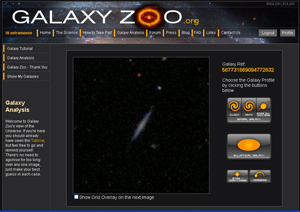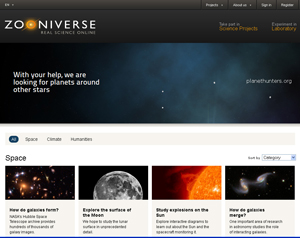Galaxy Zoo: Citizen Science with SDSS

Since 2007, the SDSS team at Johns Hopkins University has been closely involved with the Galaxy Zoo citizen science project. Galaxy Zoo allows volunteers from the general public to make contributions to real scientific research. In the original Galaxy Zoo project, volunteers looked at an image of a galaxy from the SDSS and clicked buttons to classify it as spiral or elliptical.
 |
| The original Galaxy Zoo |
The original Galaxy Zoo was hosted on servers at Johns Hopkins. Scientists and developers from JHU worked on the design of the Galaxy Zoo website and database. The original Galaxy Zoo attracted nearly 200,000 volunteers, and produced nearly 80 million classifications. These classifications have been released as part of the SDSS's Data Release 8, and have been used in more than 20 scientific papers published in peer-reviewed journals.
From Galaxy Zoo to Zooniverse
 |
| The home page of the Zooniverse web site, listing all the citizen science projects that volunteers can contribute to |
The original Galaxy Zoo is still online, but its classifications are no longer being actively used for research. But Galaxy Zoo has remained, with a more detailed classification system and data from the Hubble Space Telescope.
Galaxy Zoo has since grown into a network of citizen science projects called Zooniverse. Zooniverse projects cover many areas of science, but every project has two things in common: an easy-to-use interface to perform a simple task, and the ability to contribute meaningfully to real scientific research. Zooniverse is frequently adding new projects, expanding the reach of citizen science. The SDSS team at JHU continues to be deeply involved in planning and developing Zooniverse and other citizen science activities.